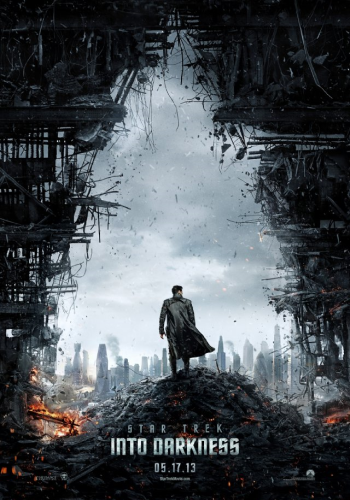JJ’s Wonky World Builds: Number 2
It always astonishes me when people defend these world-builds.
I understand the appreciation of any art is subjective. We don’t always like the same thing. There are movies I hate that others adore, and vice versa.
And I’m truly fine with all that.
The difference here is that JJ’s world building is just dumb.
It’ll fool you with its sweet visuals if you let it. JJ’s awesome at that. But if you pause to offer any scrutiny, it doesn’t take much to realise how moronic his storytelling is.
And that’s not subjective. That’s just a reality.
 It doesn’t get any stupider than Star Trek Into Darkness (2013), the second Star Trek in JJ’s rebooted timeline.
It doesn’t get any stupider than Star Trek Into Darkness (2013), the second Star Trek in JJ’s rebooted timeline.
Admiral Marcus (Peter Weller) awakens Khan Noonien Singh (Benedict Cumberbatch) – a genetically engineered superhuman – from centuries of cryogenic sleep to develop advanced weapons to help Starfleet in their ongoing conflict with the Klingons.
I really don’t have to go much further than this.
Khan has serious marquee in The Original Series timeline. A product of late twentieth-century genetics, he becomes a tyrant on Earth. When he’s finally overthrown, he and his people flee on a ship and enter cryogenic stasis. Centuries later, the crew of the Enterprise find them and, unaware of their past, revive them. Khan is initially charming, but reveals his intent when he tries to take over the ship. Kirk thwarts him, and then makes the decision to plant Khan and his people on a rugged and uninhabited planet, so that they can build their own society.
In The Wrath of Khan, it turns out the planet suffers a calamity and many of Khan’s people die, including his wife. Khan grows revengeful against Kirk, who never checked up on them in the eighteen years that have lapsed. Khan hijacks the USS Reliant, and attacks the USS Enterprise. There’s much more there, but that’s all the background you need to understand Khan.
The Wrath of Khan is a seriously good film – not just a good Star Trek film, and not just a good science fiction film, but a good film in general. Some of the tech might be dated (e.g. like push buttons), but the rest is timeless: a fantastic antagonist, a layered protagonist dealing with how he now fits into a galaxy that is leaving him behind, a great science fiction premise revolving around the Genesis device, lots of compelling drama, and riveting exchanges.
The effects themselves stand up today. The ship-to-ship battles are still the best I’ve seen in any science fiction movie – this from something that was released in 1982. The reason they’re brilliant is we’re constantly offered context. We see the damage blows inflict. We hear reports about how ships suffer. We understand how vulnerable they become, informed about what’s no longer functioning, and are told just how much more they can take.
Star Trek into Darkness’s Khan has none of this.
JJ builds his usage of Khan on what The Original Series has established and what The Wrath of Khan explored, even though this is meant to be a separate timeline where new things are happening. It’s exactly the same thing he does later with the Emperor in the Star Wars Sequel Trilogy. It’s lazy to the point of being derelict. He steals marquee from better properties and tries to use them to do the heavy lifting in his own stories.
But the stupidest thing is that Starfleet wake up a twentieth-century Khan to help them build twenty-third century weapons?
What?
This would be like reviving Alexander Graham Bell – credited as patenting the telephone in 1876 – and getting him to work for Apple on creating the new iPhone.
Star Trek also features “beaming”. A ship visits a planet, and the crew can beam down – a transporter dematerialises them from the ship and reconstitutes them on the planet, or vice versa. Originally, this was introduced as a budget-saving device because the cost of producing effects to show the ship landing on a planet were prohibitive. The transporters have always had a limited range – they purely exist as a ship-to-planet transit (and vice versa). The ship needs to be in orbit of the planet.
Star Trek into Darkness introduces transwarp beaming, so people can beam from planet to planet – and we’re talking about from a planet in one system to a planet in another system entirely. This makes the use of ships redundant.
And, of course, there’s Khan’s blood, which helps revive James Kirk (Chris Pine) from, um, death. So death is no longer a thing in this universe.
Yes, Spock is revised in Star Trek III: The Search for Spock, but it requires a string of extraordinary circumstances that will never, ever occur again.
In Star Trek into Darkness, magic blood is readily available.
How does any of this make sense?